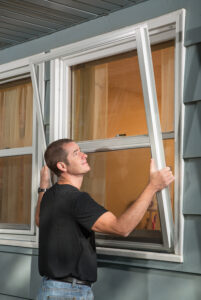
Storm Windows
Storm windows can reduce air leakage and improve the insulating value of existing windows. They can be installed on the interior or exterior side of windows and can be mounted permanently or for seasonal use. Interior storm windows can be more easily installed and removed for ventilation or cleaning.
 Storm windows can reduce air leakage. However, it is important that humid air that gets caught between a storm window and a window is allowed to escape to the outdoors. Otherwise, trapped moisture can condense on cold surfaces and cause damage. This means that exterior storm windows must not be too tight (they typically have weep holes) or that, in the case of interior storm windows, the primary window must permit some air leakage to avoid harmful condensation. On the other hand, the interior part of the window/storm window pair should be airtight.
Storm windows can reduce air leakage. However, it is important that humid air that gets caught between a storm window and a window is allowed to escape to the outdoors. Otherwise, trapped moisture can condense on cold surfaces and cause damage. This means that exterior storm windows must not be too tight (they typically have weep holes) or that, in the case of interior storm windows, the primary window must permit some air leakage to avoid harmful condensation. On the other hand, the interior part of the window/storm window pair should be airtight.
Aside from air leakage, storm windows reduce heat loss from conduction and radiation by roughly one-third if a regular storm window is installed inside or outside of a typical single-pane wood window and by at least half if the storm window has a low-E coating, which reduces heat transfer from warm to cold glass. Since storm windows do not hermetically seal the air space they create, only certain low-E options that are moisture-resistant can be used in storm windows. These low-E options reduce heat loss but do not typically significantly affect solar heat gain.
See window film or protect your art and furniture for solar heat gain reduction.
For more information on storm windows and related types, please refer to the Energy Saver guide by the Department of Energy.